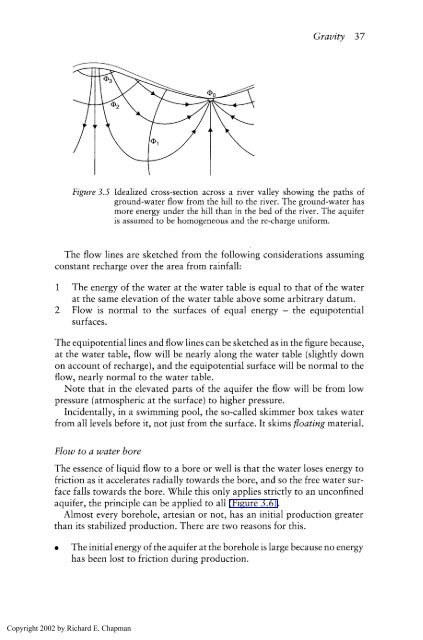Physics for Geologists, Second edition
Physics for Geologists, Second edition
Physics for Geologists, Second edition
Create successful ePaper yourself
Turn your PDF publications into a flip-book with our unique Google optimized e-Paper software.
Gravity 3 7<br />
Figure 3.5 Idealized cross-section across a river valley showing the paths of<br />
ground-water flow from the hill to the river. The ground-water has<br />
more energy under the hill than in the bed of the river. The aquifer<br />
is assumed to be homogeneous and the re-charge uni<strong>for</strong>m.<br />
The flow lines are sketched from the following considerations assuming<br />
constant recharge over the area from rainfall:<br />
1 The energy of the water at the water table is equal to that of the water<br />
at the same elevation of the water table above some arbitrary datum.<br />
2 Flow is normal to the surfaces of equal energy - the equipotential<br />
surfaces.<br />
The equipotential lines and flow lines can be sketched as in the figure because,<br />
at the water table, flow will be nearly along the water table (slightly down<br />
on account of recharge), and the equipotential surface will be normal to the<br />
flow, nearly normal to the water table.<br />
Note that in the elevated parts of the aquifer the flow will be from low<br />
pressure (atmospheric at the surface) to higher pressure.<br />
Incidentally, in a swimming pool, the so-called skimmer box takes water<br />
from all levels be<strong>for</strong>e it, not just from the surface. It skims floating material.<br />
Flow to a water bore<br />
The essence of liquid flow to a bore or well is that the water loses energy to<br />
friction as it accelerates radially towards the bore, and so the free water sur-<br />
face falls towards the bore. While this only applies strictly to an unconfined<br />
aquifer, the principle can be applied to all (Figure 3.6).<br />
Almost every borehole, artesian or not, has an initial production greater<br />
than its stabilized production. There are two reasons <strong>for</strong> this.<br />
Copyright 2002 by Richard E. Chapman<br />
The initial energy of the aquifer at the borehole is large because no energy<br />
has been lost to friction during production.






